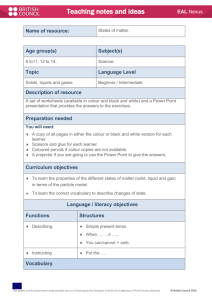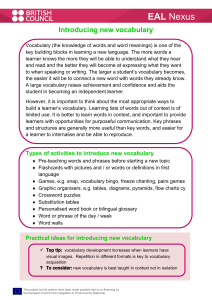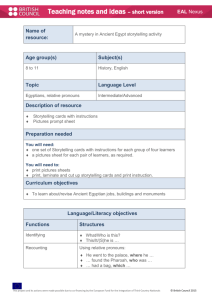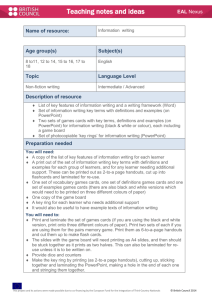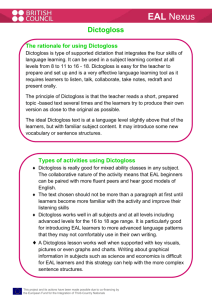in Word - Scaffolding
advertisement
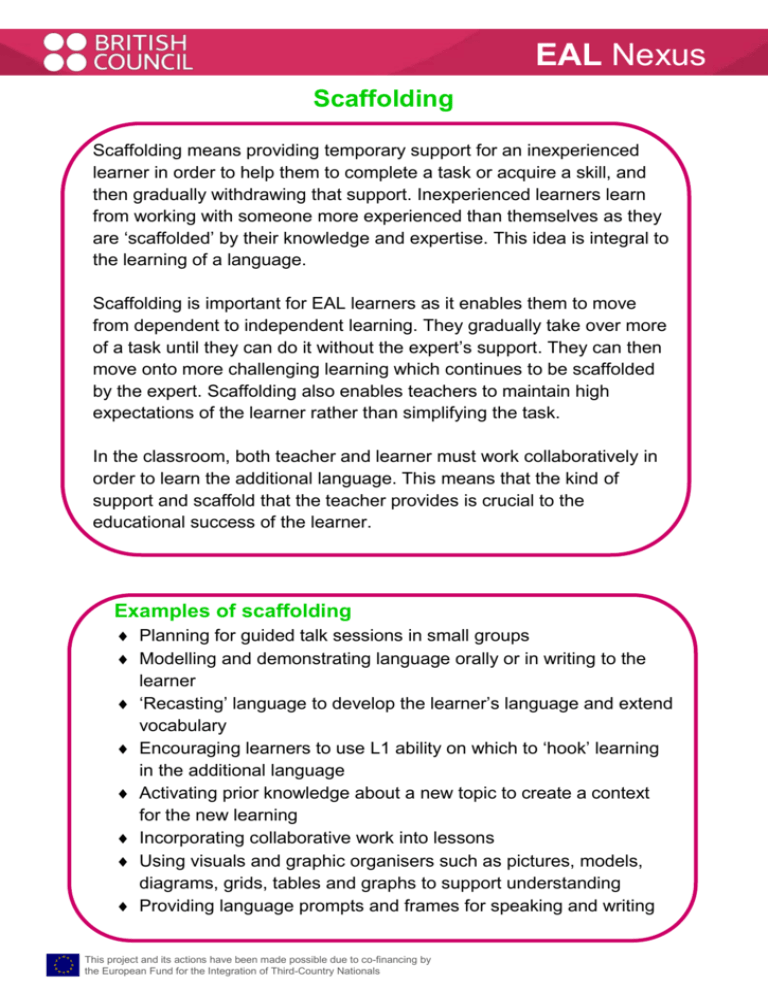
EAL Nexus Scaffolding Scaffolding means providing temporary support for an inexperienced learner in order to help them to complete a task or acquire a skill, and then gradually withdrawing that support. Inexperienced learners learn from working with someone more experienced than themselves as they are ‘scaffolded’ by their knowledge and expertise. This idea is integral to the learning of a language. Scaffolding is important for EAL learners as it enables them to move from dependent to independent learning. They gradually take over more of a task until they can do it without the expert’s support. They can then move onto more challenging learning which continues to be scaffolded by the expert. Scaffolding also enables teachers to maintain high expectations of the learner rather than simplifying the task. In the classroom, both teacher and learner must work collaboratively in order to learn the additional language. This means that the kind of support and scaffold that the teacher provides is crucial to the educational success of the learner. Examples of scaffolding Planning for guided talk sessions in small groups Modelling and demonstrating language orally or in writing to the learner ‘Recasting’ language to develop the learner’s language and extend vocabulary Encouraging learners to use L1 ability on which to ‘hook’ learning in the additional language Activating prior knowledge about a new topic to create a context for the new learning Incorporating collaborative work into lessons Using visuals and graphic organisers such as pictures, models, diagrams, grids, tables and graphs to support understanding Providing language prompts and frames for speaking and writing This project and its actions have been made possible due to co-financing by the European Fund for the Integration of Third-Country Nationals This project and its actions were made possible due to co-financing by the European Fund for the Integration of Third-Country Nationals. EAL Nexus Practical ideas for using scaffolding Top tip: Only use scaffolds as a temporary support that the learner can do without as soon as possible ? To consider: Choose the right scaffold for the task. Does it enable the teacher to maintain high challenge in a supportive way? Pre-teach key vocabulary in the learners’ first language in preparation for a task. Vocabulary could be provided or you could ask learners to use a bilingual dictionary to find out the definitions of key words. This way the learner is using what they already know in their first language as a scaffold for their learning. Read more about using learners L1 ability here In guided sessions, plan carefully for the language that will be learnt through the tasks and discussions. This is an opportunity to teach specific vocabulary, grammar or language structures in a small group. It is also a good place to extend language through discussion where the adult can address errors and can recast and remodel the correct use of language. Read more about modelling here Provide planned opportunities for learners to work collaboratively, in pairs or a group, on a task that requires a particular type of talk and has a clear outcome. If the groups are of mixed ability, contain learners who share a first language and/ or more proficient users of English, this provides a scaffold. Read more about collaborative work here When learners are working independently, provide them with scaffolds that enable them to write or speak according to a specific frame. This could be by: providing a sentence start that can be completed in different ways; using a substitution table to give the learner choices about the content of their sentence whilst still maintaining a specific structure; a whole text frame that can help them to plan the content of paragraphs. Read more about speaking and writing frames and substitution tables This project and its actions have been made possible due to co-financing by the European Fund for the Integration of Third-Country Nationals This project and its actions were made possible due to co-financing by the European Fund for the Integration of Third-Country Nationals. EAL Nexus Use visuals to accompany text to aid the reader’s understanding and to help them to access the curriculum. For example: an illustration to accompany new vocabulary; a diagram to accompany text such as an explanation; a map to aid understanding of given directions. Read more about visuals here Graphic organisers can be provided by the teacher or developed with the learner to: develop understanding of the structure of a text; summarise the main ideas from a text; organise the main points of an oral discussion in preparation for a formal presentation or written task; use to plan the content of a written task. Read more about graphic organisers here Find out what learners already know about a new topic to be introduced by: using KWL grids (what they know, what they want to know and what they have learnt by the end); using artefacts, pictures and illustrations e.g. discussing pictures of a variety of leaders from around the world before beginning a study of Henry VIII; using bilingual strategies such as providing key vocabulary or discussing current understanding in L1. This way, EAL learners can make links with their understanding of concepts and knowledge of the subject in L1. By activating prior knowledge, the learner is able to ‘hook’ the new learning onto what they already know. Good for EAL, Good for All: Can I use scaffolding with the whole class? Yes, all learners benefit from scaffolding to learn language, whether this is learning English as a mother tongue or acquiring it an additional language. This project and its actions have been made possible due to co-financing by the European Fund for the Integration of Third-Country Nationals This project and its actions were made possible due to co-financing by the European Fund for the Integration of Third-Country Nationals.
